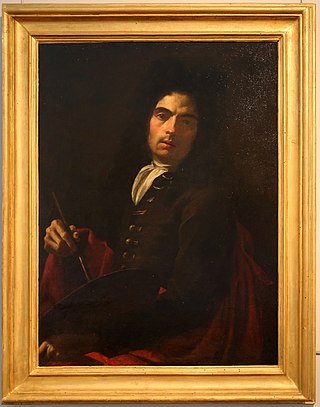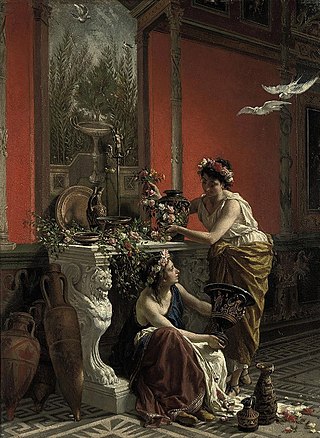Related Research Articles

Annibale Carracci was an Italian painter and instructor, active in Bologna and later in Rome. Along with his brother and cousin, Annibale was one of the progenitors, if not founders of a leading strand of the Baroque style, borrowing from styles from both north and south of their native city, and aspiring for a return to classical monumentality, but adding a more vital dynamism. Painters working under Annibale at the gallery of the Palazzo Farnese would be highly influential in Roman painting for decades.

Luca Giordano was an Italian late-Baroque painter and printmaker in etching. Fluent and decorative, he worked successfully in Naples and Rome, Florence, and Venice, before spending a decade in Spain.

Guido Reni was an Italian painter of the Baroque period, although his works showed a classical manner, similar to Simon Vouet, Nicolas Poussin, and Philippe de Champaigne. He painted primarily religious works, but also mythological and allegorical subjects. Active in Rome, Naples, and his native Bologna, he became the dominant figure in the Bolognese School that emerged under the influence of the Carracci.

Pinturicchio, or Pintoricchio, also known as Benetto di Biagio or Sordicchio, was an Italian painter during the Renaissance. He acquired his nickname because of his small stature and he used it to sign some of his artworks that were created during the fifteenth and sixteenth centuries.

Belisario Corenzio was a Greek-Italian painter, active in Venice and Naples. He is one of few Greek painters that did not belong to the Cretan Renaissance like his contemporaries of the time. He escaped the maniera greca completely. He adopted the Venetian style. Other similar Greek painters were Marco Basaiti, Ioannis Permeniates, Antonio Vassilacchi and El Greco. He was sometimes referred to as Il Greco. His teacher was prominent Venetian painter Tintoretto. In 1590, at age 32 Corenzio settled in Naples. Corenzio was influenced by Cavalier d'Arpino. He continued to flourish in the region. His apprentices included: Luigi Rodriguez, Andrea di Leone, Onofrio De Lione and Massimo Stanzione. Corenzio painted many frescos that survived today. Some of his works are in the Church of San Severino and Certosa di San Martino. His style resembles Caravaggio. An Italian legend in Naples exists involving Corenzio, Spanish painter Jusepe de Ribera, and Battistello Caracciolo. They were referred to as the Cabal of Naples. The three painters were rumored to have poisoned their competition for painting contracts. The rumors lack documented evidence. The three painters were very popular in Naples. Corenzio frescoed the Crypt that holds the remains of Matthew the Apostle at Salerno Cathedral and it depicts scenes from the Gospel of Matthew. Corenzio was one of the most celebrated fresco painters in Naples during his time. His drawings can be found all over the world namely at the Metropolitan Museum, Museo di Capodimonte and Louvre.

Corrado Giaquinto was an Italian Rococo painter.

Giovanni Lanfranco was an Italian painter of the Baroque period.

Sant'Anna dei Lombardi,, and also known as Santa Maria di Monte Oliveto, is an ancient church and convent located in piazza Monteoliveto in central Naples, Italy. Across Monteoliveto street from the Fountain in the square is the Renaissance palace of Orsini di Gravina.

Cristoforo Roncalli was an Italian mannerist painter. He was one of the three painters known as Pomarancio or Il Pomarancio.

Guglielmo Borremans or Guglielmo Fiamingo (1670–1744) was a Flemish painter whose documented career took principally place in Italy, in particular Naples, Cosenza and Sicily. Here he was one of the pre-eminent late-Baroque fresco painters of the first half of the 17th century who received multiple commissions to decorate churches and palaces.

Cesare Mariani was an Italian painter and architect of the late-19th century, active in Rome and Ascoli Piceno.

Giuseppe Nicola Nasini was an Italian painter of the Baroque period, active in Rome and Tuscany.

Giuseppe Cammarano was an Italian painter and leader of the Academy of Arts in his birthplace of Sciacca, Sicily.
Camillo Guerra was an Italian painter, active mainly in Naples, Italy.

The church of Santi Severino e Sossio and the annexed monastery are located on via Bartolommeo Capasso in Naples, Italy.

Enrico Salfi was an Italian painter, mainly of biblical or Ancient Roman (Pompeian) subjects. He also excelled in oil portraits.
Luigi Pastore was an Italian painter.

Angelo Mozzillo was an Italian painter of the late Baroque, active near Naples, Italy.
Gennaro Maldarelli was an Italian painter of the Neoclassic style.

Paolo de Maio or Paolo de Majo was an Italian painter of the late-Baroque or Rococo period.
References
- 1 2 3 A.M. Comanducci, Biography (in Italian)
- 1 2 Presentazione monografia sul pittore caiatino Severino in Caserta News, 17 April 2009 (in Italian)
- ↑ ‘‘Dizionario degli Artisti Italiani Viventi: pittori, scultori, e Architetti.’’, by Angelo de Gubernatis. Tipe dei Successori Le Monnier, 1889, page 470-471.
- ↑ Short biography.
- ↑ Vicenzo Severino Exhibition., Article by Vittorio Giorgi.